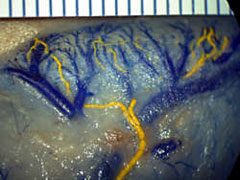Challenging the Known
By Susan Murley
In life, certain things seem obvious. You get wet when it rains. A car stops when it runs out of gas. A kettle creates steam when it boils. The sun revolves around the earth. (Scratch that last one.)
In science, certain things also seem obvious. For brain physiologists, it was clear that cerebrospinal fluid (CSF), the fluid that bathes and protects the brain and spinal cord, was absorbed from the cranium through a site called the arachnoid granulations. Every doctor in medical school was taught that this was the way it worked. Period. End of story.
Until Dr. Miles Johnston and his team decided one day out of simple scientific curiosity to check if the conventional wisdom on CSF absorption was true. Much to their surprise, it wasn’t.
Johnston discovered that cerebrospinal fluid is absorbed not through the arachnoid granulations, but through the lymphatic system. What made this find so interesting is that there are no lymphatic vessels located in the brain.
So how does the lymphatic system carry fluid from the brain if it doesn’t have any vessels located in that organ? Nerves coming out of the base of the skull carry a “sleeve” of cerebrospinal fluid in the space around the nerve, and lymphatic vessels in the thin layer of tissue surrounding the nerve absorb this fluid.
Johnston used a contrast agent or dye called Microfil to see the process of absorption, and could trace the path from the cerebrospinal fluid in the brain through to the lymphatic pathways. His images demonstrated clearly that CSF drained through this mechanism.
It was interesting for Johnston just to make this connection and correct a scientific fallacy. But it was even more exciting when he considered the future possible implications of the discovery. “It’s an interesting time in the research for us because this whole project started as a relatively straightforward physiological question and has led us to a new concept that could have significant impact in the field of hydrocephalus,” Johnston muses.
Hydrocephalus is an abnormal accumulation of cerebrospinal fluid in the brain, and it is a very prevalent disease. One to three of 1,000 live births have hydrocephalus, and the condition can also be caused by trauma, bleeding in the brain and stroke. Another form of hydrocephalus affects the elderly and mimics Alzheimer’s.
“A good place to start any consideration of new therapies is to have the correct concept of how the system works under normal circumstances,” says Johnston. “Our work has caused us to rethink this significant clinical problem, because the only treatment for hydrocephalus is a shunt, a plastic tube inserted into the ventricles of the brain. These shunts block; there are problems in the valves. A shunt obstruction in a child is a medical emergency. One-half litre of CSF is formed a day, and it’s being formed within the context of an enclosed cranial vault, so there is no place for it to go. If the absorption isn’t effective, it’s big trouble – it can cause death.”
For such a common problem, few people study it. Hydrocephalus is seen as a “plumbing problem,” Johnston says, “and plumbing problems aren’t fashionable.” Most of the research currently being done in this field is directed towards creating a better shunt. But as Johnston points out, “if there are going to be any major breakthroughs in treatment it has to come from a new concept, and surely the place to start is an understanding of the basic factors that govern the transport of cerebrospinal fluid.”
Johnston and his team are now looking to try to make the link between the mechanisms of CSF absorption and hydrocephalus clearer. If transport of fluid through the lymph system is blocked, does pressure in the skull rise? Does blocked transport of fluid lead to dilation of the ventricles of the brain, which is the defining symptom of hydrocephalus?
Johnston cautions that there is still a lot of work to do, and they are “still far from providing the decisive link between lymphatics and hydrocephalus.” He feels certain, however, that for all the complexity of the disease, problems with absorption will play a large role.
For Johnston, one of the most thought-provoking parts of the research has not been the discovery of this new mechanism, but learning about how new knowledge is received and the necessity of continuing to probe accepted concepts. “The issue is that we must continue to question accepted dogma. When we first started to present the research at meetings, people wouldn’t accept it at all, because this was not what they were taught. So in that sense, it has really been a lot of fun, because people have not wanted to believe it, but the story is the data. We’re winning people over slowly.”
PDF / View full media release »







